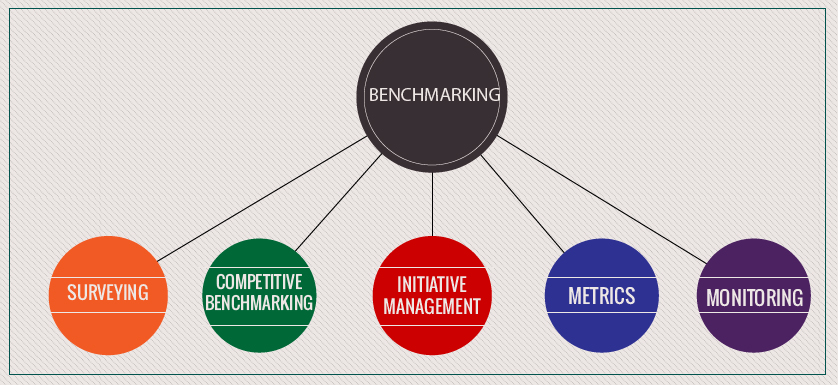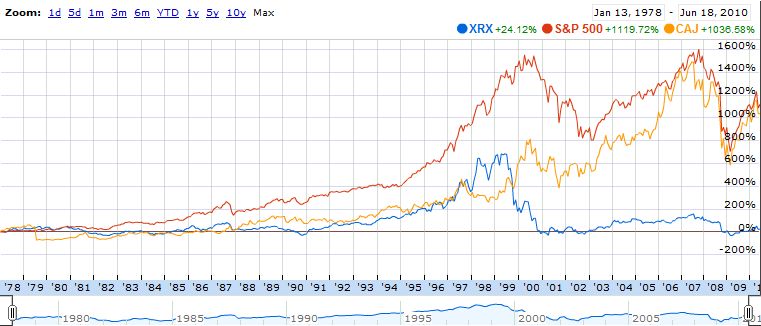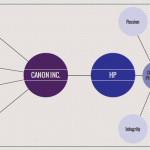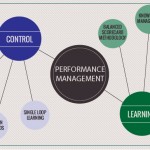Benchmarking, Rank Xerox and Canon
smartKPIs.com Performance Architect update 24/2010
Benchmarking as a management concept is reported to have its roots in land surveying, where the altitude of objects is estimated based on a pre-established point of reference on an arbitrary landmark (McNary, 1994). Frederick Taylor is reported to be the first to use benchmarking along with other principles in a business enterprise to improve performance. Elements of benchmarking can be recognized in Taylor’s scientific management approach applied during his time at Bethlehem Steel Company (McNary, 1994), popularized in “The Principles of Scientific Management” .
Benchmarking as we know it today was first applied by the Xerox Corporation in later 70s, early 80s. Faced with increased competition from Japanese imports, Xerox set upon improve its order fulfillment process and other processes deemed unproductive. One of the first accounts of the “competitive benchmarking” approach at Xerox was given in 1992 by Rob Walker, the Director of Business Management Systems and Quality at Rank Xerox (U.K.) Ltd. at the time. In his article “Rank Xerox – Management Revolution”, he describes in detail the challenges, changes made and impact of the “competitive benchmarking” approach at the company. Under the “competitive benchmarking” initiative. Xerox compared itself to its Japanese competitors as well as large organizations operating outside of the industry: “American Express for billing and collections, American Hospital Supply for automated inventory control, LL Bean for distribution, warehousing and order-taking” (Walker, 1992).
The ascent of benchmarking in the 80s resulted in numerous books and articles published, reflected in the business environment by an increase in the use of benchmarking around the world. Comparing to others is natural to humans, so benchmarking was rather easy to understand in theory. Applying it in practice and generating value from it is a different story.
In sports and tennis in particular, performance metrics are monitored by players and coaches to track progress and how the game plan was executed. In terms of benchmarking KPIs between players, this needs to be explored with care. The playing style is different from one player to another. One player might have a very powerful serve, but generally inaccurate. Another might have a high percentage of net approaches, but ineffective. On top of this, in tennis the concentration power and determination is in many instances more important than game statistics. Similarly, in business, many companies zoom to a different tune. While benchmarking sounds good in theory, there are many practical issues relating to data accuracy and relevance of results. There are many questions organisations need to clarify before embarking on such a road:
a. Who may the beneficiaries of such an exercise be?
b. What is the added value?
c. Who has done this well?
The graph below raises another question:
Source: Google Finance, 2010
Did it ultimately work for Rank Xerox?
or even
What did Canon differently to generate such a gap between the stock price performance over the last 10 years?
Comparing performance across entities is even easier today. Availability of information technology and rich datasets facilitates benchmarking across multiple dimensions. However, embarking on benchmarking initiatives because “it seems to be a popular tool” or because it was recommended by a consultant can be risky. Same as if it is pursued “just because we can” or with unreliable data. Done properly, it might still be a good idea overall, but then another question needs to be asked:
Are there any other better ideas?
Yet again, Study puts initiatives management in a new light.
Stay smart! Enjoy smartKPIs.com!
Aurel Brudan
Performance Architect, www.smartKPIs.com
References
- McNary, Lisa D. 1994, “Thinking about excellence and benchmarking”, The Journal for Quality and Participation, July-August 1994, v17, n4, p90(1)
- Walker, Rob 1992, “Rank Xerox – Management Revolution”, Long Range Planning, Vol. 25, No. 1, pp. 9 to 21
Walker, Rob 1992,“Rank Xerox – Management Revolution”, Long Range Planning, Vol. 25, No. 1, pp. 9 to 21

Tags: Aurel Brudan, Benchmarking, Performance Architect Update







